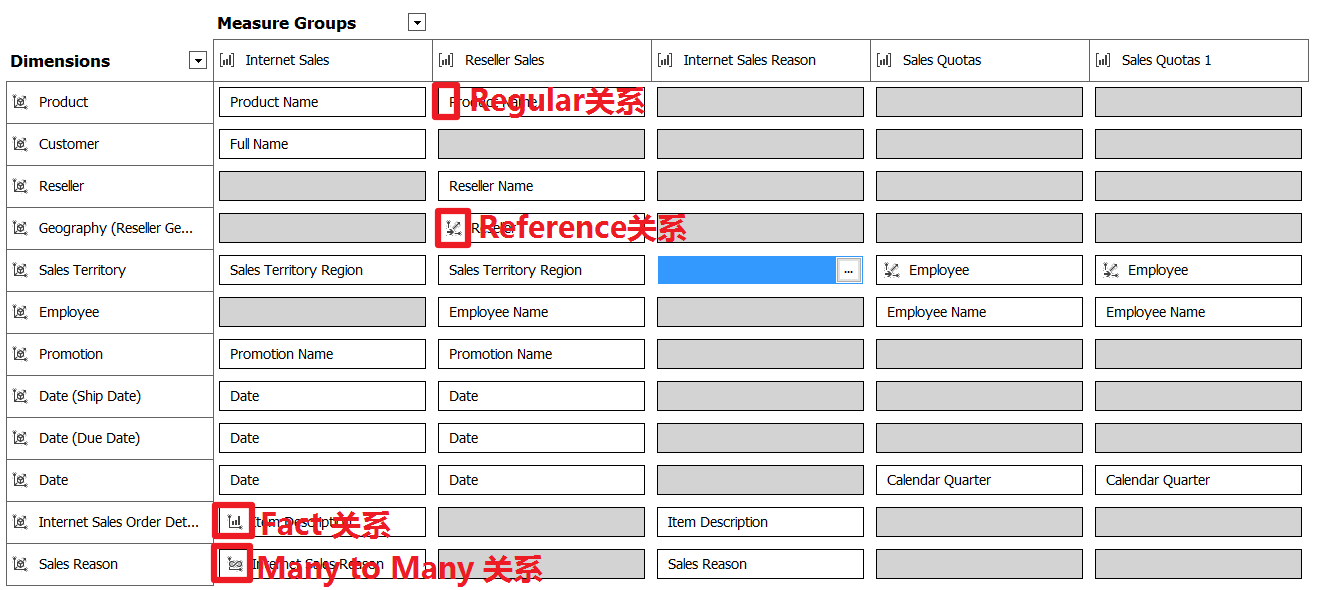SSAS:概念梳理
Dimension Objects
A simple Dimension object is composed of basic information, attributes, and hierarchies.
Basic information includes the name of the dimension, the type of the dimension, the data source, the storage mode, and others.
Attributes define the actual data in the dimension.
Attributes do not necessarily belong to a hierarchy, but hierarchies are built from attributes.
A hierarchy creates ordered lists of levels, and defines the ways a user can explore the dimension.
Dimensions are a fundamental component of cubes.
Dimensions organize data with relation to an area of interest, such as customers, stores, or employees, to users.
Dimensions in Analysis Services contain attributes that correspond to columns in dimension tables.
These attributes appear as attribute hierarchies and can be organized into user-defined hierarchies, or can be defined as parent-child hierarchies based on columns in the underlying dimension table.
Hierarchies are used to organize measures that are contained in a cube.
Cube Objects
A simple Cube object is composed of: basic information, dimensions, and measure groups.
Basic information includes the name of the cube, the default measure of the cube, the data source, the storage mode, and others.
The Dimensions collection contains the actual set of dimensions used in the cube from the database dimensions colection.
All dimensions have to be defined in the dimensions collection of the database before being referenced in the cube.
Private dimensions are not available in Microsoft SQL Server Analysis Services.
Measure groups are sets of measures in the cube.
A measure group is a collection of measures that have a common data source view and a common set of dimensions.
A measure group is the unit of process for measures; measure groups can be processed individually and then browsed.
- Actions (Analysis Services - Multidimensional Data)
- Aggregations and Aggregation Designs
- Calculations
- Cube Cells (Analysis Services - Multidimensional Data)
- Cube Properties - Multidimensional Model Programming
- Cube Storage (Analysis Services - Multidimensional Data)
- Cube Translations
- Dimension Relationships
- Key Performance Indicators (KPIs) in Multidimensional Models
- Measures and Measure Groups
- Partitions (Analysis Services - Multidimensional Data)
- Perspectives
Dimension Relationships 维度间的关系
- Regular:当Dimension表的键列直接连接到Fact表时,多维数据集维度(Cube Dimension)和度量值组(Measures Group)之间存在常规维度关系。 此直接关系基于底层关系数据库中的主键 - 外键关系,但也可能基于在数据源视图中定义的逻辑关系。 常规维关系表示传统星型模式设计中维度表和事实表之间的关系。
- Reference:当Dimension表的键列通过另一个Dimension表中的键间接连接到Fact表时,Cube Dimension和度量值组(Measures Group)之间存在引用维度关系(Reference Relationship)。
- Fact Dimension:通常称为简并维度(degenerate dimensions),是从Fact表中的属性列而不是Dim表中的属性列构建的标准维度。 (通常指Fact表与Fact表有直接的关联关系)
- Many to Many:在大多数维度中,每个事实连接到一个且仅一个维度成员,并且单个维度成员可以与多个事实相关联。 在关系数据库术语中,这被称为一对多关系。 然而,将单个事实连接到多个维度成员通常是有用的。 例如,银行客户可能具有多个帐户(支票,储蓄,信用卡和投资帐户),并且帐户也可以具有联合或多个所有者。 (通常需要在逻辑关系中,两张表中间使用一张表作为多对多的关联关系表)

版权声明:
作者:莫不逢
出处:http://www.cnblogs.com/sitemanager/
Github:https://github.com/congjf
本文版权归作者和博客园共有,欢迎转载,但未经作者同意必须保留此段声明,且在文章页面明显位置给出原文连接,否则保留追究法律责任的权利。




 浙公网安备 33010602011771号
浙公网安备 33010602011771号